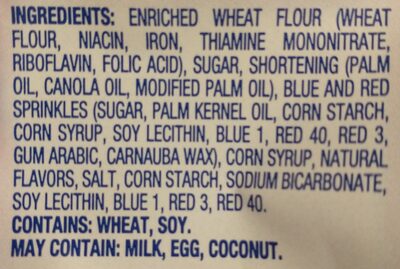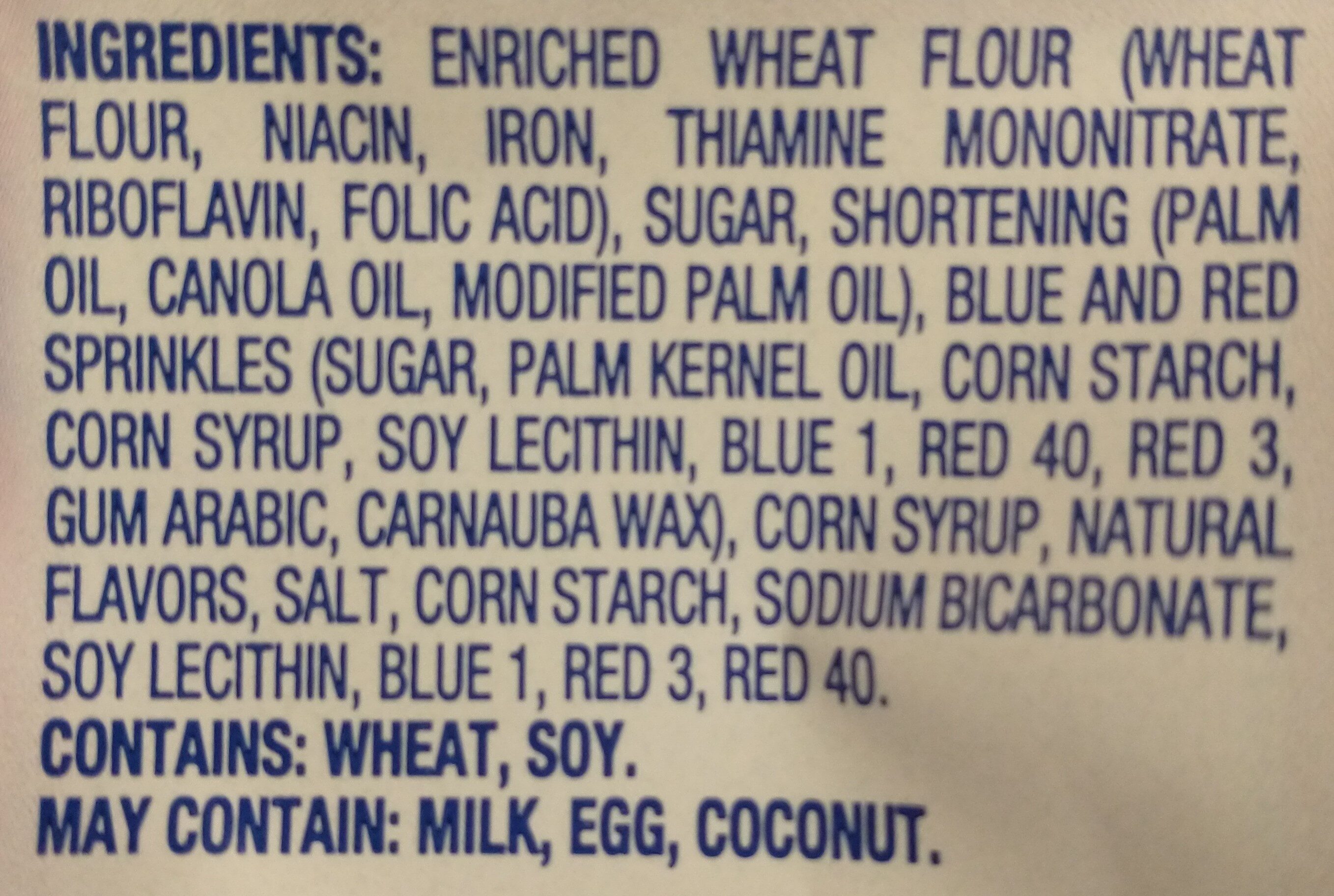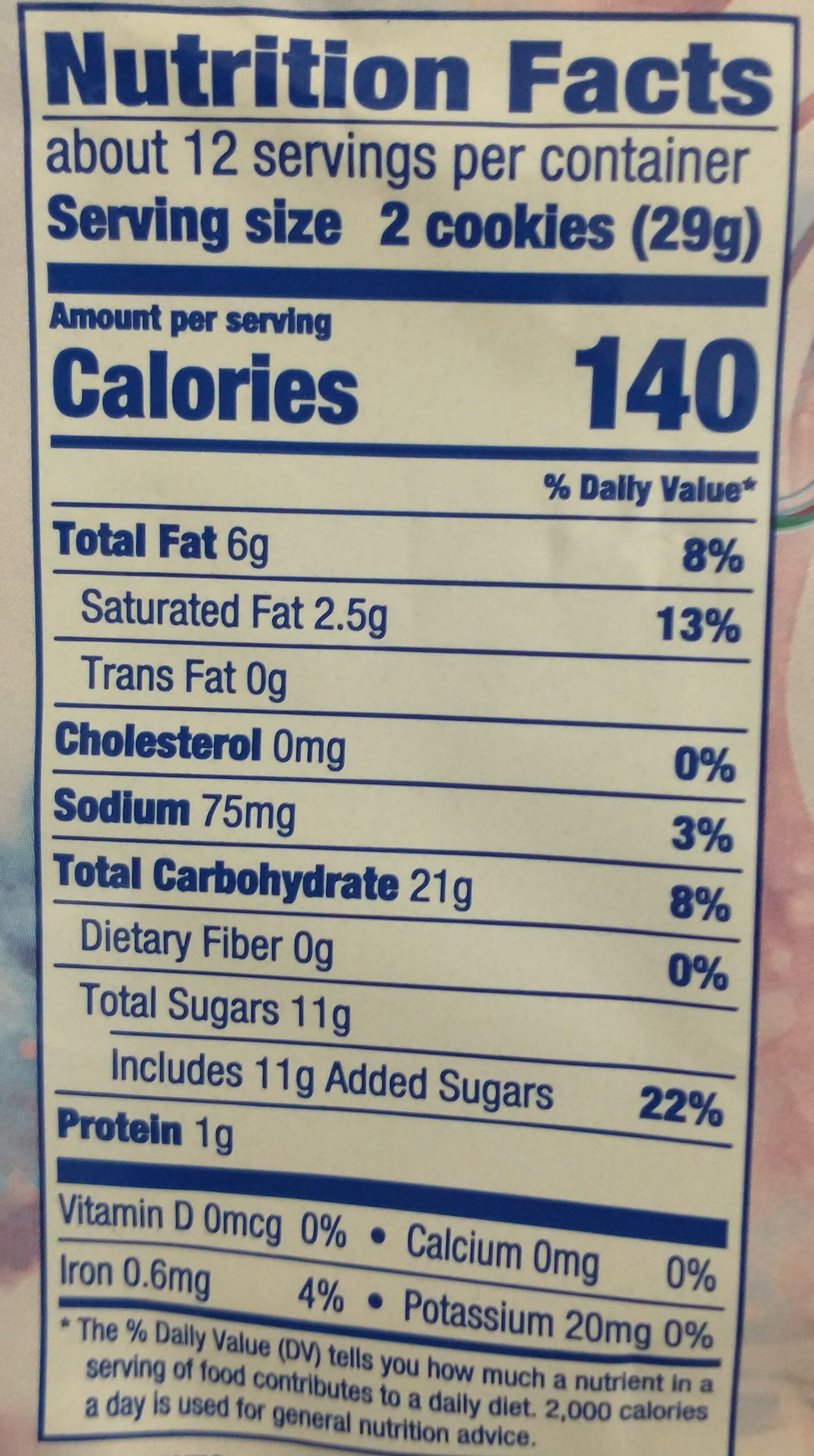Help us make food transparency the norm!
As a non-profit organization, we depend on your donations to continue informing consumers around the world about what they eat.
The food revolution starts with you!
Kaleidos Unicorn Cookies - Kroger - 12 oz (340g)
Kaleidos Unicorn Cookies - Kroger - 12 oz (340g)
This product page is not complete. You can help to complete it by editing it and adding more data from the photos we have, or by taking more photos using the app for Android or iPhone/iPad. Thank you!
×
Barcode: 0011110046802 (EAN / EAN-13) 011110046802 (UPC / UPC-A)
Common name: Sandwich Cookies
Quantity: 12 oz (340g)
Packaging: Plastic, Tray, Wrapper, Cellophane
Brands: Kroger
Categories: Snacks, Sweet snacks, Confectioneries, Biscuits and cakes, Biscuits, Candies
Stores: Kroger
Countries where sold: United States
Matching with your preferences
Health
Ingredients
-
33 ingredients
ENRICHED WHEAT FLOUR (WHEAT FLOUR, NIACIN, IRON, THIAMINE MONONITRATE, RIBOFLAVIN, FOLIC ACID), SUGAR, SHORTENING (PALM OIL, CANOLA OIL, MODIFIED PALM OIL), NONPAREILS (SUGAR, PALM KERNEL OIL, CORN STARCH, CORN SYRUP, SOY LECITHIN, BLUE 1, RED 40, RED 3, GUM ARABIC, CARNAUBA WAX), CORN SYRUP, NATURAL FLAVORS, SALT, CORN STARCH, SODIUM BICARBONATE, SOY LECITHIN, BLUE 1, RED 3, RED 40. CONTAINS: WHEAT, SOY. MAY CONTAIN: MILK, EGG, COCONUT.Allergens: Gluten, SoybeansTraces: Eggs, Milk, Coconut
Food processing
-
Ultra processed foods
Elements that indicate the product is in the 4 - Ultra processed food and drink products group:
- Additive: E127 - Erythrosine
- Additive: E129 - Allura red
- Additive: E133 - Brilliant blue FCF
- Additive: E322 - Lecithins
- Additive: E414 - Acacia gum
- Additive: E903 - Carnauba wax
- Ingredient: Flavouring
Food products are classified into 4 groups according to their degree of processing:
- Unprocessed or minimally processed foods
- Processed culinary ingredients
- Processed foods
- Ultra processed foods
The determination of the group is based on the category of the product and on the ingredients it contains.
Additives
-
E127 - Erythrosine
Erythrosine: Erythrosine, also known as Red No. 3, is an organoiodine compound, specifically a derivative of fluorone. It is cherry-pink synthetic, primarily used for food coloring. It is the disodium salt of 2‚4,5‚7-tetraiodofluorescein. Its maximum absorbance is at 530 nm in an aqueous solution, and it is subject to photodegradation.Source: Wikipedia
-
E129 - Allura red
Allura Red AC: Allura Red AC is a red azo dye that goes by several names, including FD&C Red 40. It is used as a food dye and has the E number E129. It is usually supplied as its red sodium salt, but can also be used as the calcium and potassium salts. These salts are soluble in water. In solution, its maximum absorbance lies at about 504 nm.Source: Wikipedia
-
E133 - Brilliant blue FCF
Brilliant Blue FCF: Brilliant Blue FCF -Blue 1- is an organic compound classified as a triarylmethane dye and a blue azo dye, reflecting its chemical structure. Known under various commercial names, it is a colorant for foods and other substances. It is denoted by E number E133 and has a color index of 42090. It has the appearance of a blue powder. It is soluble in water, and the solution has a maximum absorption at about 628 nanometers.Source: Wikipedia
-
E322 - Lecithins
Lecithins are natural compounds commonly used in the food industry as emulsifiers and stabilizers.
Extracted from sources like soybeans and eggs, lecithins consist of phospholipids that enhance the mixing of oil and water, ensuring smooth textures in various products like chocolates, dressings, and baked goods.
They do not present any known health risks.
-
E322i - Lecithin
Lecithins are natural compounds commonly used in the food industry as emulsifiers and stabilizers.
Extracted from sources like soybeans and eggs, lecithins consist of phospholipids that enhance the mixing of oil and water, ensuring smooth textures in various products like chocolates, dressings, and baked goods.
They do not present any known health risks.
-
E414 - Acacia gum
Gum arabic: Gum arabic, also known as acacia gum, arabic gum, gum acacia, acacia, Senegal gum and Indian gum, and by other names, is a natural gum consisting of the hardened sap of various species of the acacia tree. Originally, gum arabic was collected from Acacia nilotica which was called the "gum arabic tree"; in the present day, gum arabic is collected from acacia species, predominantly Acacia senegal and Vachellia -Acacia- seyal; the term "gum arabic" does not indicate a particular botanical source. In a few cases so‐called "gum arabic" may not even have been collected from Acacia species, but may originate from Combretum, Albizia or some other genus. Producers harvest the gum commercially from wild trees, mostly in Sudan -80%- and throughout the Sahel, from Senegal to Somalia—though it is historically cultivated in Arabia and West Asia. Gum arabic is a complex mixture of glycoproteins and polysaccharides. It is the original source of the sugars arabinose and ribose, both of which were first discovered and isolated from it, and are named after it. Gum arabic is soluble in water. It is edible, and used primarily in the food industry as a stabilizer, with EU E number E414. Gum arabic is a key ingredient in traditional lithography and is used in printing, paint production, glue, cosmetics and various industrial applications, including viscosity control in inks and in textile industries, though less expensive materials compete with it for many of these roles. While gum arabic is now produced throughout the African Sahel, it is still harvested and used in the Middle East.Source: Wikipedia
-
E903 - Carnauba wax
Carnauba wax: Carnauba -; Portuguese: carnaúba [kaʁnɐˈubɐ]-, also called Brazil wax and palm wax, is a wax of the leaves of the palm Copernicia prunifera -Synonym: Copernicia cerifera-, a plant native to and grown only in the northeastern Brazilian states of Piauí, Ceará, Maranhão, Bahia, and Rio Grande do Norte. It is known as "queen of waxes" and in its pure state, usually comes in the form of hard yellow-brown flakes. It is obtained from the leaves of the carnauba palm by collecting and drying them, beating them to loosen the wax, then refining and bleaching the wax.Source: Wikipedia
Ingredients analysis
-
Palm oil
Ingredients that contain palm oil: Palm oil, Modified palm oil, Palm kernel oil
-
Vegan status unknown
Unrecognized ingredients: Iron, Thiamin mononitrate, Folic acid, Nonpareils
-
Vegetarian status unknown
Unrecognized ingredients: Iron, Thiamin mononitrate, Folic acid, Nonpareils
-
Details of the analysis of the ingredients
: ENRICHED WHEAT FLOUR (WHEAT FLOUR, NIACIN, IRON, THIAMINE MONONITRATE, RIBOFLAVIN, FOLIC ACID), SUGAR, SHORTENING (PALM OIL, CANOLA OIL, MODIFIED PALM OIL), NONPAREILS (SUGAR, PALM KERNEL OIL, CORN STARCH, CORN SYRUP, SOY LECITHIN, BLUE 1, RED 40, RED 3, GUM ARABIC, CARNAUBA WAX), CORN SYRUP, NATURAL FLAVORS, SALT, CORN STARCH, SODIUM BICARBONATE, SOY LECITHIN, BLUE 1, RED 3, RED 40, COCONUT- ENRICHED WHEAT FLOUR -> en:fortified-wheat-flour - vegan: yes - vegetarian: yes - ciqual_proxy_food_code: 9410 - percent_min: 7.14285714285714 - percent_max: 100
- WHEAT FLOUR -> en:wheat-flour - vegan: yes - vegetarian: yes - ciqual_proxy_food_code: 9410 - percent_min: 1.19047619047619 - percent_max: 100
- NIACIN -> en:e375 - vegan: maybe - vegetarian: maybe - percent_min: 0 - percent_max: 50
- IRON -> en:iron - percent_min: 0 - percent_max: 33.3333333333333
- THIAMINE MONONITRATE -> en:thiamin-mononitrate - percent_min: 0 - percent_max: 25
- RIBOFLAVIN -> en:e101 - vegan: maybe - vegetarian: yes - percent_min: 0 - percent_max: 20
- FOLIC ACID -> en:folic-acid - percent_min: 0 - percent_max: 16.6666666666667
- SUGAR -> en:sugar - vegan: yes - vegetarian: yes - ciqual_proxy_food_code: 31016 - percent_min: 0 - percent_max: 37.9
- SHORTENING -> en:fat - vegan: maybe - vegetarian: maybe - from_palm_oil: maybe - percent_min: 0 - percent_max: 33.3333333333333
- PALM OIL -> en:palm-oil - vegan: yes - vegetarian: yes - from_palm_oil: yes - ciqual_food_code: 16129 - percent_min: 0 - percent_max: 33.3333333333333
- CANOLA OIL -> en:canola-oil - vegan: yes - vegetarian: yes - from_palm_oil: no - percent_min: 0 - percent_max: 16.6666666666667
- MODIFIED PALM OIL -> en:modified-palm-oil - vegan: yes - vegetarian: yes - from_palm_oil: yes - ciqual_food_code: 16129 - percent_min: 0 - percent_max: 11.1111111111111
- NONPAREILS -> en:nonpareils - percent_min: 0 - percent_max: 25
- SUGAR -> en:sugar - vegan: yes - vegetarian: yes - ciqual_proxy_food_code: 31016 - percent_min: 0 - percent_max: 25
- PALM KERNEL OIL -> en:palm-kernel-oil - vegan: yes - vegetarian: yes - from_palm_oil: yes - percent_min: 0 - percent_max: 12.5
- CORN STARCH -> en:corn-starch - vegan: yes - vegetarian: yes - ciqual_food_code: 9510 - percent_min: 0 - percent_max: 8.33333333333333
- CORN SYRUP -> en:corn-syrup - vegan: yes - vegetarian: yes - ciqual_proxy_food_code: 31089 - percent_min: 0 - percent_max: 6.25
- SOY LECITHIN -> en:soya-lecithin - vegan: yes - vegetarian: yes - ciqual_food_code: 42200 - percent_min: 0 - percent_max: 5
- BLUE 1 -> en:e133 - vegan: yes - vegetarian: yes - percent_min: 0 - percent_max: 4.16666666666667
- RED 40 -> en:e129 - vegan: yes - vegetarian: yes - percent_min: 0 - percent_max: 3.57142857142857
- RED 3 -> en:e127 - vegan: yes - vegetarian: yes - percent_min: 0 - percent_max: 3.125
- GUM ARABIC -> en:e414 - vegan: yes - vegetarian: yes - percent_min: 0 - percent_max: 2.77777777777778
- CARNAUBA WAX -> en:e903 - vegan: yes - vegetarian: yes - percent_min: 0 - percent_max: 2.5
- CORN SYRUP -> en:corn-syrup - vegan: yes - vegetarian: yes - ciqual_proxy_food_code: 31089 - percent_min: 0 - percent_max: 20
- NATURAL FLAVORS -> en:natural-flavouring - vegan: maybe - vegetarian: maybe - percent_min: 0 - percent_max: 5
- SALT -> en:salt - vegan: yes - vegetarian: yes - ciqual_food_code: 11058 - percent_min: 0 - percent_max: 0.647
- CORN STARCH -> en:corn-starch - vegan: yes - vegetarian: yes - ciqual_food_code: 9510 - percent_min: 0 - percent_max: 0.647
- SODIUM BICARBONATE -> en:e500ii - vegan: yes - vegetarian: yes - percent_min: 0 - percent_max: 0.647
- SOY LECITHIN -> en:soya-lecithin - vegan: yes - vegetarian: yes - ciqual_food_code: 42200 - percent_min: 0 - percent_max: 0.647
- BLUE 1 -> en:e133 - vegan: yes - vegetarian: yes - percent_min: 0 - percent_max: 0.647
- RED 3 -> en:e127 - vegan: yes - vegetarian: yes - percent_min: 0 - percent_max: 0.647
- RED 40 -> en:e129 - vegan: yes - vegetarian: yes - percent_min: 0 - percent_max: 0.647
- COCONUT -> en:coconut - vegan: yes - vegetarian: yes - ciqual_proxy_food_code: 15006 - percent_min: 0 - percent_max: 0.647
- ENRICHED WHEAT FLOUR -> en:fortified-wheat-flour - vegan: yes - vegetarian: yes - ciqual_proxy_food_code: 9410 - percent_min: 7.14285714285714 - percent_max: 100
Nutrition
-
Bad nutritional quality
⚠ ️Warning: the amount of fruits, vegetables and nuts is not specified on the label, it was estimated from the list of ingredients: 3This product is not considered a beverage for the calculation of the Nutri-Score.
Positive points: 0
- Proteins: 2 / 5 (value: 3.45, rounded value: 3.45)
- Fiber: 0 / 5 (value: 0, rounded value: 0)
- Fruits, vegetables, nuts, and colza/walnut/olive oils: 0 / 5 (value: 3.48774776785715, rounded value: 3.5)
Negative points: 24
- Energy: 6 / 10 (value: 2020, rounded value: 2020)
- Sugars: 8 / 10 (value: 37.9, rounded value: 37.9)
- Saturated fat: 8 / 10 (value: 8.62, rounded value: 8.6)
- Sodium: 2 / 10 (value: 259, rounded value: 259)
The points for proteins are not counted because the negative points are greater or equal to 11.
Nutritional score: (24 - 0)
Nutri-Score:
-
Nutrient levels
-
Fat in high quantity (20.7%)
What you need to know- A high consumption of fat, especially saturated fats, can raise cholesterol, which increases the risk of heart diseases.
Recommendation: Limit the consumption of fat and saturated fat- Choose products with lower fat and saturated fat content.
-
Saturated fat in high quantity (8.62%)
What you need to know- A high consumption of fat, especially saturated fats, can raise cholesterol, which increases the risk of heart diseases.
Recommendation: Limit the consumption of fat and saturated fat- Choose products with lower fat and saturated fat content.
-
Sugars in high quantity (37.9%)
What you need to know- A high consumption of sugar can cause weight gain and tooth decay. It also augments the risk of type 2 diabetes and cardio-vascular diseases.
Recommendation: Limit the consumption of sugar and sugary drinks- Sugary drinks (such as sodas, fruit beverages, and fruit juices and nectars) should be limited as much as possible (no more than 1 glass a day).
- Choose products with lower sugar content and reduce the consumption of products with added sugars.
-
Salt in moderate quantity (0.647%)
What you need to know- A high consumption of salt (or sodium) can cause raised blood pressure, which can increase the risk of heart disease and stroke.
- Many people who have high blood pressure do not know it, as there are often no symptoms.
- Most people consume too much salt (on average 9 to 12 grams per day), around twice the recommended maximum level of intake.
Recommendation: Limit the consumption of salt and salted food- Reduce the quantity of salt used when cooking, and don't salt again at the table.
- Limit the consumption of salty snacks and choose products with lower salt content.
-
-
Nutrition facts
Nutrition facts As sold
for 100 g / 100 mlAs sold
per serving (29g)Compared to: Candies Energy 2,020 kj
(483 kcal)586 kj
(140 kcal)+36% Fat 20.7 g 6 g +956% Saturated fat 8.62 g 2.5 g +568% Salt 0.647 g 0.188 g +398% Carbohydrates 72.4 g 21 g -12% Fiber 0 g 0 g -100% Sugars 37.9 g 11 g -36% Proteins 3.45 g 1 g +103% Iron 2.07 mg 0.6 mg +876% Potassium 69 mg 20 mg +2% Fruits‚ vegetables‚ nuts and rapeseed‚ walnut and olive oils (estimate from ingredients list analysis) 3.488 % 3.488 %
Environment
-
Eco-Score D - High environmental impact
The Eco-Score is an experimental score that summarizes the environmental impacts of food products.→ The Eco-Score was initially developped for France and it is being extended to other European countries. The Eco-Score formula is subject to change as it is regularly improved to make it more precise and better suited to each country.Life cycle analysis
-
Average impact of products of the same category: B (Score: 62/100)
Category: Candies, all types
Category: Candies, all types
- PEF environmental score: 0.41 (the lower the score, the lower the impact)
- including impact on climate change: 1.73 kg CO2 eq/kg of product
Stage Impact Agriculture
78.2 %Processing
10.7 %Packaging
5.5 %Transportation
4.5 %Distribution
1.1 %Consumption
0.0 %
Bonuses and maluses
-
Missing origins of ingredients information
Malus: -5
⚠ ️ The origins of the ingredients of this product are not indicated.
If they are indicated on the packaging, you can modify the product sheet and add them.
If you are the manufacturer of this product, you can send us the information with our free platform for producers.
-
Ingredients that threatens species
Malus: -10
Contains palm oil
Tropical forests in Asia, Africa and Latin America are destroyed to create and expand oil palm tree plantations. The deforestation contributes to climate change, and it endangers species such as the orangutan, the pigmy elephant and the Sumatran rhino.
-
Packaging with a high impact
Malus: -15
Shape Material Recycling Impact Cellophane Plastic High Wrapper Unknown High Tray Unknown High ⚠ ️ The information about the packaging of this product is not sufficiently precise (exact shapes and materials of all components of the packaging).⚠ ️ For a more precise calculation of the Eco-Score, you can modify the product page and add them.
If you are the manufacturer of this product, you can send us the information with our free platform for producers.
Eco-Score for this product
-
Impact for this product: D (Score: 32/100)
Product: Kaleidos Unicorn Cookies - Kroger - 12 oz (340g)
Life cycle analysis score: 62
Sum of bonuses and maluses: -30
Final score: 32/100
-
Carbon footprint
-
Equal to driving 0.9 km in a petrol car
173 g CO² per 100g of product
The carbon emission figure comes from ADEME's Agribalyse database, for the category: Candies, all types (Source: ADEME Agribalyse Database)
Stage Impact Agriculture
52.3 %Processing
19.5 %Packaging
15.7 %Transportation
11.6 %Distribution
1.0 %Consumption
0.0 %
Packaging
-
Packaging with a high impact
-
Packaging parts
Cellophane (Plastic)
Wrapper
Tray
-
Packaging materials
Material % Packaging weight Packaging weight per 100 g of product Plastic
-
Transportation
-
Origins of ingredients
Missing origins of ingredients information
⚠ ️ The origins of the ingredients of this product are not indicated.
If they are indicated on the packaging, you can modify the product sheet and add them.
If you are the manufacturer of this product, you can send us the information with our free platform for producers.Add the origins of ingredients for this product Add the origins of ingredients for this product
Threatened species
-
Contains palm oil
Drives deforestation and threatens species such as the orangutan
Tropical forests in Asia, Africa and Latin America are destroyed to create and expand oil palm tree plantations. The deforestation contributes to climate change, and it endangers species such as the orangutan, the pigmy elephant and the Sumatran rhino.
Report a problem
-
Incomplete or incorrect information?
Category, labels, ingredients, allergens, nutritional information, photos etc.
If the information does not match the information on the packaging, please complete or correct it. Open Food Facts is a collaborative database, and every contribution is useful for all.
Data sources
Product added on by manateebison
Last edit of product page on by manateebison.








